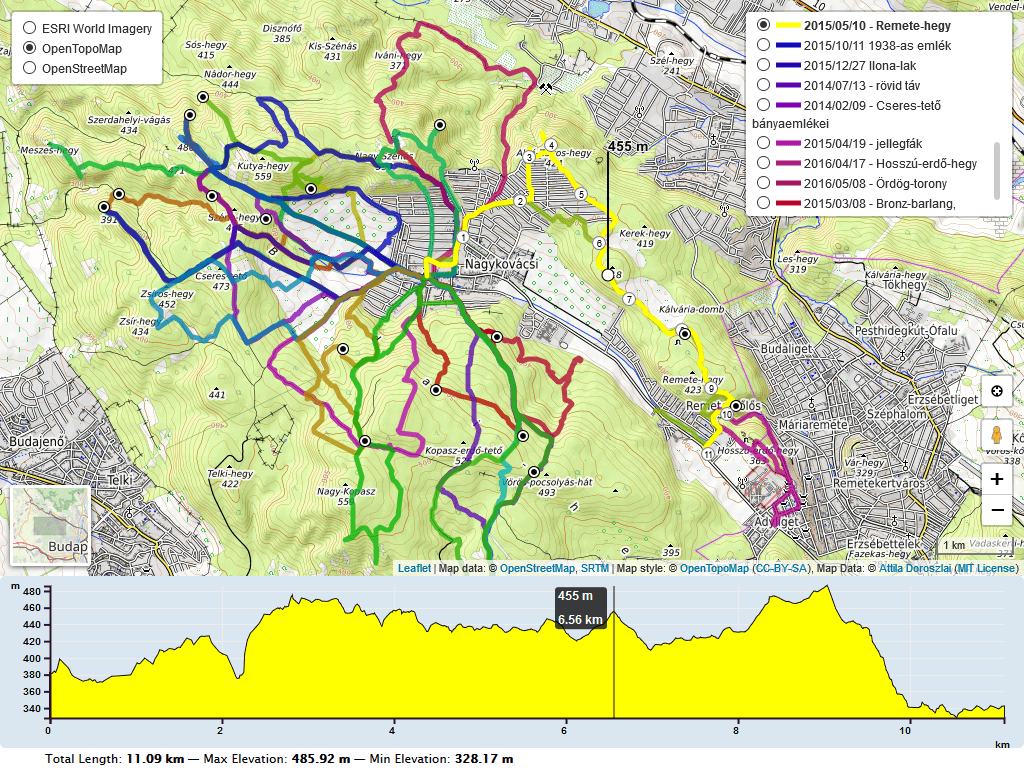A Leaflet plugin that allows to add elevation profiles using d3js
For a working example see one of the following demos:
- loading .gpx file
- loading .geojson file
- loading .kml file
- loading .tcx file
- loading strings
- loading geojson group
- loading local .gpx file
- hoverable chart / hidden map
- hoverable chart / hidden chart
- hoverable tracks
- toggable tracks
- toggable charts
Initially based on the work of Felix “MrMufflon” Bache
- include CSS & JavaScript
<head> ... <style> html, body, #map, #elevation-div { height: 100%; width: 100%; padding: 0; margin: 0; } #map { height: 75%; } #elevation-div { height: 25%; font: 12px/1.5 "Helvetica Neue", Arial, Helvetica, sans-serif; } </style> <!-- leaflet-ui --> <script src="https://unpkg.com/leaflet@1.3.2/dist/leaflet.js"></script> <script src="https://unpkg.com/leaflet-ui@0.2.0/dist/leaflet-ui.js"></script> <!-- leaflet-elevation --> <link rel="stylesheet" href="https://unpkg.com/@raruto/leaflet-elevation/dist/leaflet-elevation.css" /> <script src="https://unpkg.com/@raruto/leaflet-elevation/dist/leaflet-elevation.js"></script> ... </head>
- choose the div container used for the slippy map
<body> ... <div id="map"></div> ... </body>
- create your first simple “leaflet-elevation” slippy map
<script> // Full list options at "leaflet-elevation.js" var elevation_options = { // Default chart colors: theme lime-theme, magenta-theme, ... theme: "lightblue-theme", // Chart container outside/inside map container detached: true, // if (detached), the elevation chart container elevationDiv: "#elevation-div", // if (!detached) autohide chart profile on chart mouseleave autohide: false, // if (!detached) initial state of chart profile control collapsed: false, // if (!detached) control position on one of map corners position: "topright", // Autoupdate map center on chart mouseover. followMarker: true, // Autoupdate map bounds on chart update. autofitBounds: true, // Chart distance/elevation units. imperial: false, // [Lat, Long] vs [Long, Lat] points. (leaflet default: [Lat, Long]) reverseCoords: false, // Acceleration chart profile: true || "summary" || "disabled" || false acceleration: false, // Slope chart profile: true || "summary" || "disabled" || false slope: false, // Speed chart profile: true || "summary" || "disabled" || false speed: false, // Display time info: true || "summary" || false time: false, // Display distance info: true || "summary" distance: true, // Display altitude info: true || "summary" altitude: true, // Summary track info style: "line" || "multiline" || false summary: 'multiline', // Toggle chart ruler filter. ruler: true, // Toggle chart legend filter. legend: true, // Toggle "leaflet-almostover" integration almostOver: true, // Toggle "leaflet-distance-markers" integration distanceMarkers: false, // Render chart profiles as Canvas or SVG Paths preferCanvas: true }; // Instantiate map (leaflet-ui). var map = new L.Map('map', { mapTypeId: 'terrain', center: [41.4583, 12.7059], zoom: 5 }); // Instantiate elevation control. var controlElevation = L.control.elevation(elevation_options).addTo(map); // Load track from url (allowed data types: "*.geojson", "*.gpx", "*.tcx") controlElevation.load("https://raruto.github.io/leaflet-elevation/examples/via-emilia.gpx"); </script>
Related: Leaflet-UI presets, QGIS Integration
Contributors: MrMufflon, HostedDinner, ADoroszlai, Raruto





